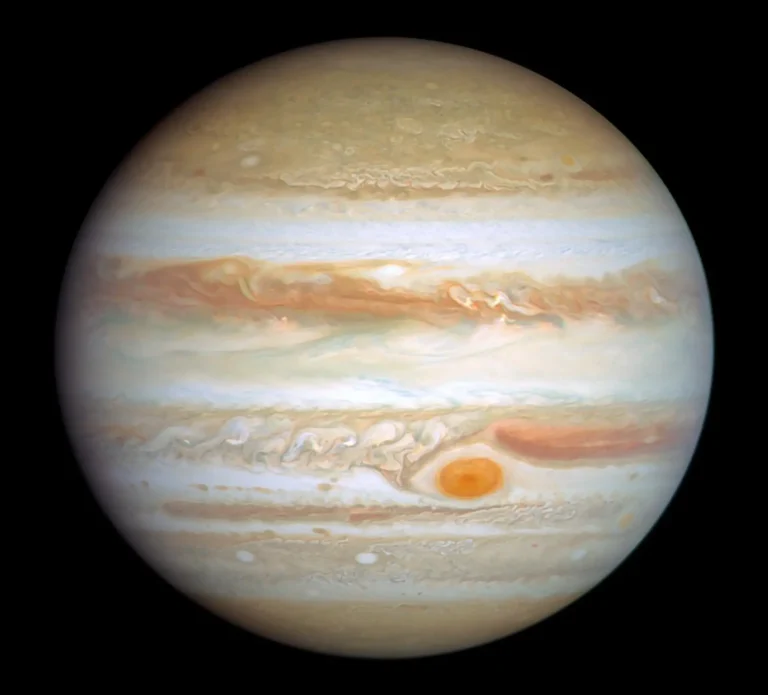Understanding Composition of Jupiter
Jupiter is the largest planet in our solar system, often called a gas giant because it’s primarily made of gases rather than solid rock. But what exactly is Jupiter made of? In this article, we’ll take a deep dive into Jupiter’s composition—layer by layer—to understand the makeup of this colossal planet.

The Atmosphere of Jupiter
Jupiter’s outermost layer—the part we see through telescopes—is its atmosphere. This layer is massive and extends thousands of kilometers deep. It’s also the region where the planet’s iconic stripes and storms form.
Main Elements:
- Hydrogen (about 89.8%)
- Helium (about 10.2%)
These proportions are very similar to the Sun, which is why some scientists believe Jupiter could be a “failed star.”
Trace Gases (in very small amounts):
- Methane (CH₄)
- Ammonia (NH₃)
- Hydrogen sulfide (H₂S)
- Water vapor (H₂O)
- Neon, argon, and other noble gases
These gases contribute to Jupiter’s colorful cloud bands and dynamic weather systems.
The Cloud Layers
Jupiter’s clouds are not uniform; they form distinct layers at different altitudes due to variations in temperature and chemical composition.
Cloud Layers from Top to Bottom:
- Ammonia Ice Clouds:
- These are the highest clouds, white in appearance.
- They form at around -145°C (−234°F).
- Ammonium Hydrosulfide Clouds:
- Located beneath the ammonia clouds.
- These contribute to the brownish colors we see from Earth.
- Water Ice and Vapor Clouds:
- The deepest visible layer.
- Thought to be similar to Earth’s clouds but under much higher pressure.
These cloud layers drive Jupiter’s turbulent weather systems, including cyclones and jet streams that whip around the planet at hundreds of miles per hour.
The Gaseous Hydrogen Envelope
As we go deeper below the cloud layers, the gases are subjected to intense pressure and temperature. Here, hydrogen remains in molecular form (H₂) but begins to behave more like a liquid than a gas.
- This zone extends for tens of thousands of kilometers.
- It contains liquid hydrogen due to extreme pressure (but it’s not boiling or bubbling like water).
This region acts like an ocean of hydrogen, flowing smoothly and conducting heat within the planet.
The Metallic Hydrogen Layer
This is one of the most fascinating and exotic layers of Jupiter.
What is Metallic Hydrogen?
- Under pressure over 3 million times Earth’s atmospheric pressure, hydrogen atoms break apart and form a fluid that behaves like a metal.
- It can conduct electricity and generate magnetic fields—just like metals on Earth.
- This layer is likely responsible for Jupiter’s incredibly strong magnetic field, the largest in the solar system.
Conditions in this layer:
- Pressure: >3 million atmospheres.
- Temperature: 10,000–20,000°C (18,000–36,000°F).
- State: Superheated, electrically conductive fluid.
This is not a metallic solid, but a metallic liquid that rotates and drives Jupiter’s magnetosphere.
Jupiter’s Core (Possibly Rocky or Icy)
At the center of Jupiter lies a core, although there’s still debate over its exact nature. Most models suggest:
Core Characteristics:
- Composed of rock, metal, and possibly ice.
- Surrounded by dense layers of metallic and liquid hydrogen
- Estimated size: 5 to 15 times the mass of Earth.
- May not be a sharply defined solid—possibly a “fuzzy” or partially dissolved core.
Scientists believe that early in its history, Jupiter may have formed around a solid or icy core, which later became buried under massive layers of hydrogen and helium.
Final Thoughts
Jupiter is more than just a gas giant—it’s a layered, complex world made primarily of hydrogen and helium, but shaped by extreme pressure, high-speed winds, and exotic forms of matter like metallic hydrogen. Its unique composition not only defines its appearance and magnetism but also offers valuable insights into how giant planets form across the universe.
Read Similar Articles


